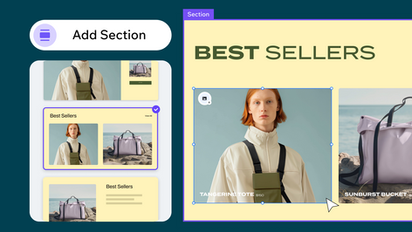What Is Best Website Designs 2025?
Best Website Designs 2025 Trends
Best Website Designs 2025
Web design is crucial for any business looking to establish a strong online presence. A well-designed website not only attracts visitors but also keeps them engaged and interested in your brand. With constantly evolving technology and trends, it is essential to stay updated on the latest web design ideas to ensure your website remains visually appealing and user-friendly. In this article, we will discuss some creative web design ideas that can help elevate your website and make it stand out from the competition.

How Best Website Designs 2025 Works
Best Website Designs 2025
Benefits of a One Pager Website:
1. Simple and Easy to Navigate: One pager websites are designed to be simple and easy to navigate, making it easier for visitors to find the information they need quickly and efficiently.
2. Cost-Effective: Building a one pager website is more cost-effective than a traditional multi-page website. You can save on hosting fees, design costs, and maintenance fees by having a single webpage.
3. Mobile-Friendly: With the increasing use of mobile devices, it is important to have a website that is responsive and mobile-friendly. One pager websites are designed to be easily viewable on all devices, ensuring a seamless user experience.
4. Improved SEO: Having a one pager website can improve your search engine rankings as it allows you to focus on specific keywords and content. This can help drive more traffic to your website and increase your online visibility.
5. Quick Load Times: One pager websites have faster load times compared to multi-page websites, ensuring that visitors can access your site quickly and easily.
How to Build a One Pager Website:
1. Define Your Goals and Target Audience: Before you start building your one pager website, it is important to define your goals and identify your target audience. Determine what you want to achieve with your website and who you are trying to reach.
2. Choose a Website Builder: There are several website builders available that make it easy to create a one pager website without any coding knowledge. Popular website builders include Wix, Squarespace, and WordPress. Choose a platform that best suits your needs and budget.
3. Select a Template: Most website builders offer a variety of templates to choose from. Select a template that aligns with your brand and conveys the message you want to communicate to your audience.
4. Customize Your Design: Once you have selected a template, you can customize the design of your one pager website. Add your logo, choose a color scheme, and upload high-quality images that represent your business effectively.
5. Create Compelling Content: The content on your one pager website should be concise, engaging, and informative. Include a brief overview of your business, highlight your products or services, and provide contact information for visitors to reach out to you.
6. Include Calls to Action: Encourage visitors to take action on your one pager website by including clear and compelling calls to action. This could be signing up for a newsletter, requesting a quote, or making a purchase.
7. Optimize for SEO: Improve the visibility of your one pager website by optimizing it for search engines. Use relevant keywords, meta tags, and alt text for images to improve your search engine rankings.
8. Test and Launch: Before launching your one pager website, make sure to test it on different devices and browsers to ensure that it is functional and looks great. Once you are satisfied with the design and content, you can launch your website and start promoting it to your target audience.
Wix is a popular website builder that is known for its user-friendly interface and drag-and-drop design capabilities. With Wix, users can choose from a wide variety of pre-designed templates that can be customized to fit their needs. Whether you’re looking to create a personal blog, online store, or portfolio, Wix has templates that cater to various industries and interests.
One of the main advantages of using Wix is its drag-and-drop editor, which allows users to easily customize their websites without any coding knowledge. With Wix, you can simply drag elements like text boxes, images, and videos onto your webpage and arrange them in the desired layout. This makes it easy for beginners to create a visually appealing website without having to hire a professional web designer.
Additionally, Wix offers a range of features that make building a website even easier. For example, Wix’s ADI (Artificial Design Intelligence) tool can automatically create a customized website for you based on your preferences. This is a great option for those who are short on time or design skills and need a website up and running quickly.
Wix also offers a variety of add-ons and integrations that can enhance your website’s functionality. From e-commerce tools for selling products online to marketing features for promoting your site, Wix has everything you need to create a professional website that meets your specific needs.
In addition to its easy-to-use design tools, Wix also provides excellent customer support to help ensure that your website-building experience goes smoothly. Whether you have a question about using a specific feature or need technical assistance, Wix’s customer support team is available to help you every step of the way.
Another key advantage of using Wix is its affordable pricing. Wix offers a range of pricing plans to suit different needs and budgets, making it a cost-effective option for individuals and businesses alike. Whether you’re looking to create a simple personal website or a feature-rich e-commerce site, Wix has a plan that fits your requirements.
Overall, Wix is a great choice for those looking to build a website quickly and easily. With its intuitive design tools, customizable templates, and range of features, Wix makes it simple for anyone to create a professional-looking website without the need for advanced technical skills. Whether you’re a small business owner, blogger, or freelancer, Wix has everything you need to create a stunning website that showcases your brand or personality.

Getting Started with Best Website Designs 2025
Best Website Designs 2025
In today’s digital age, having a visually appealing and user-friendly website is crucial for the success of any business. A well-designed website can help attract new customers, build credibility, and increase conversion rates. However, designing a website is not as simple as it may seem. It requires a strategic and systematic approach to ensure that the final product meets the needs and expectations of both the business and its target audience. In this article, we will discuss the website design process in detail, outlining the key steps involved in creating a successful website.
Step 1: Define the Purpose and Goals
The first step in the website design process is to clearly define the purpose and goals of the website. This involves identifying the target audience, understanding their needs and preferences, and determining the desired outcomes for the website. For example, is the website meant to generate leads, drive sales, provide information, or showcase products and services? By having a clear understanding of the purpose and goals of the website, you can better tailor the design and content to meet these objectives.
Step 2: Conduct Research
Once the purpose and goals of the website have been defined, the next step is to conduct research. This involves analyzing the competition, researching industry trends, and gathering insights into the preferences and behaviors of the target audience. By conducting thorough research, you can gain a better understanding of what works and what doesn’t in your industry, helping you make informed design decisions.
Step 3: Create a Wireframe
After conducting research, the next step in the website design process is to create a wireframe. A wireframe is a visual representation of the layout and structure of the website, showing the placement of various elements such as navigation menus, headers, footers, and content sections. Creating a wireframe allows you to plan the overall design and functionality of the website before moving on to the visual design phase.
Step 4: Design the Visual Elements
Once the wireframe has been finalized, the next step is to design the visual elements of the website. This involves creating a visually appealing and consistent design that reflects the brand identity and resonates with the target audience. Elements such as color scheme, typography, imagery, and layout are carefully considered to create a cohesive and attractive design that conveys the desired message and engages users.
Step 5: Develop the Website
After the visual design has been approved, the next step is to develop the website. This involves coding the design into a functioning website using HTML, CSS, and other programming languages. During the development phase, the website is tested for functionality, responsiveness, and compatibility across different devices and browsers to ensure a seamless user experience.
Step 6: Test and Optimize
Once the website has been developed, it is essential to test and optimize its performance. This involves conducting usability tests to identify any usability issues, testing load times to ensure fast page speeds, and optimizing the website for search engines to improve visibility and accessibility. By testing and optimizing the website, you can ensure that it meets the needs and expectations of users, leading to better engagement and conversions.
Step 7: Launch and Monitor
The final step in the website design process is to launch the website and monitor its performance. This involves deploying the website to a live server, promoting it to the target audience, and tracking key metrics such as traffic, engagement, and conversions. By monitoring the performance of the website, you can identify areas for improvement and make informed decisions to optimize its effectiveness over time.


